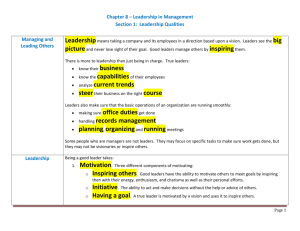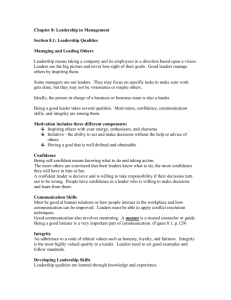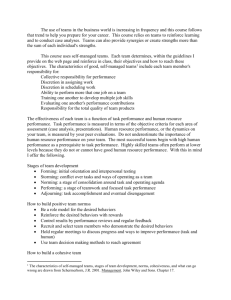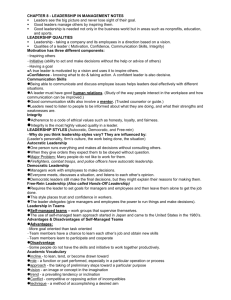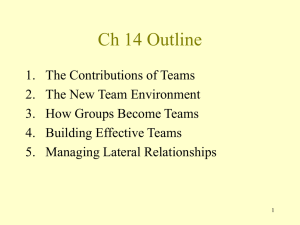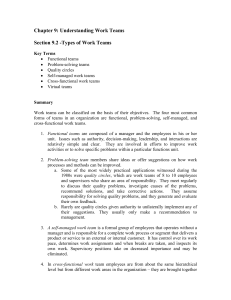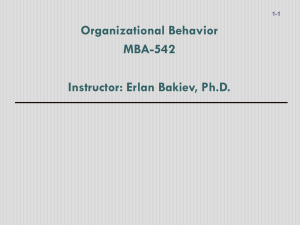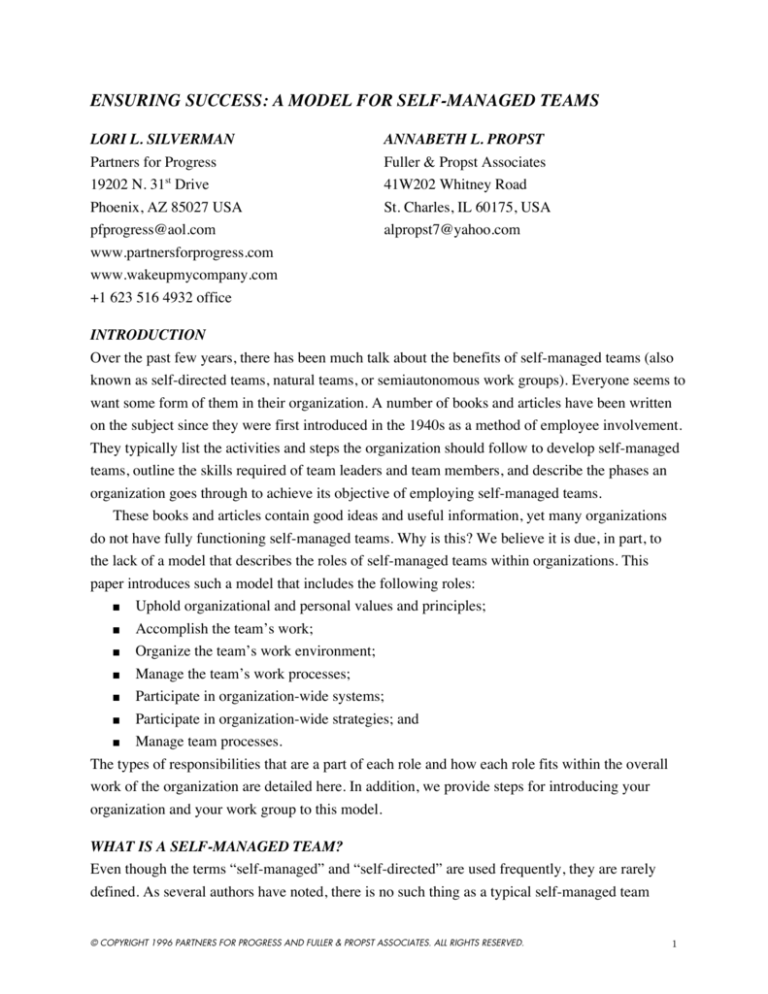
ENSURING SUCCESS: A MODEL FOR SELF-MANAGED TEAMS
LORI L. SILVERMAN
Partners for Progress
19202 N. 31st Drive
Phoenix, AZ 85027 USA
pfprogress@aol.com
www.partnersforprogress.com
www.wakeupmycompany.com
+1 623 516 4932 office
ANNABETH L. PROPST
Fuller & Propst Associates
41W202 Whitney Road
St. Charles, IL 60175, USA
alpropst7@yahoo.com
INTRODUCTION
Over the past few years, there has been much talk about the benefits of self-managed teams (also
known as self-directed teams, natural teams, or semiautonomous work groups). Everyone seems to
want some form of them in their organization. A number of books and articles have been written
on the subject since they were first introduced in the 1940s as a method of employee involvement.
They typically list the activities and steps the organization should follow to develop self-managed
teams, outline the skills required of team leaders and team members, and describe the phases an
organization goes through to achieve its objective of employing self-managed teams.
These books and articles contain good ideas and useful information, yet many organizations
do not have fully functioning self-managed teams. Why is this? We believe it is due, in part, to
the lack of a model that describes the roles of self-managed teams within organizations. This
paper introduces such a model that includes the following roles:
■
Uphold organizational and personal values and principles;
■
Accomplish the team’s work;
■
Organize the team’s work environment;
■
Manage the team’s work processes;
■
Participate in organization-wide systems;
■
Participate in organization-wide strategies; and
■
Manage team processes.
The types of responsibilities that are a part of each role and how each role fits within the overall
work of the organization are detailed here. In addition, we provide steps for introducing your
organization and your work group to this model.
WHAT IS A SELF-MANAGED TEAM?
Even though the terms “self-managed” and “self-directed” are used frequently, they are rarely
defined. As several authors have noted, there is no such thing as a typical self-managed team
© COPYRIGHT 1996 PARTNERS FOR PROGRESS AND FULLER & PROPST ASSOCIATES. ALL RIGHTS RESERVED.
1
(Holpp, 1993, Shonk, 1992). Yet, it has been our experience that having a common definition
can serve as a framework for discussion and dialogue on this topic.
In 1990, Development Dimensions International, the Association for Quality and
Participation, and Industry Week conducted a study on the current practice surrounding selfdirected teams. The study defined a self-directed team as
“a group of employees who have day-to-day responsibility for managing themselves and the
work they do. Members of self-directed teams typically handle job assignments, plan and
schedule work, make production-related decisions, and take action on problems. Members of
self-directed teams work with a minimum of direct supervision. As such, the teams are not
quality circles or cross-functional task groups. ... [T]hese teams are characterized by:
■
Face-to-face interaction in natural work groups;
■
Responsibility for producing a definable product;
■
Responsibility for a set of interdependent tasks; and
■
Control over managing and executing tasks.” (page 4)
This definition outlines the “end state” to which work groups evolve when they finally
become self-managed teams. However, organizations also need to understand the process
surrounding how teams become self-managed over time. Zawacki and Norman (1994) suggest
that successful self-managed teams evolve through five stages. These are:
■
Stage 1: The typical hierarchical structure where the leader provides one-on-one
supervision;
■
Stage 2: The leader evolves into a group manager whose role is making the transition into
team coordinator/coach;
■
Stage 3: The group manager becomes the team coordinator and provides a structure for
self-managed team members to receive the necessary training to take on more leadership
tasks;
■
Stage 4: The team assumes most of the duties previously reserved for the group manager,
who now becomes a boundary interface; and
■
Stage 5: The group manager (i.e., the team coordinator) is a resource for the team.
We concur with Zawacki and Norman (1994) that a typical organization can have self-managed
teams in each of these five stages at various times. Teams can (and will) revert back to earlier
stages as team membership changes over time. In addition, it is our experience that a team may
operate in a different stage in each of the seven roles. For example, a team could be performing
Stage 3 responsibilities within the role “accomplishing the work” and Stage 1 responsibilities
within the role “participating in organization-wide strategies.”
WHY USE SELF-MANAGED TEAMS?
What rationale does an organization use to encourage its teams to move from Stage 1 through
to Stage 5? First and foremost is the desire to promote customer satisfaction. As a team moves
© COPYRIGHT 1996 PARTNERS FOR PROGRESS AND FULLER & PROPST ASSOCIATES. ALL RIGHTS RESERVED.
2
toward Stage 5, members typically receive customer requirements and feedback directly, rather
than filtered through a supervisor. Team members are also able to use this first-hand information
to respond appropriately to customers and thus continually increase their own learning over time.
In addition, the cycle time for making on-the-spot customer-related decisions is shortened.
A second reason organizations move toward self-managed teams is the desire to promote
employee satisfaction. Human potential has the opportunity to be cultivated and exercised to its
fullest extent as team members take on additional roles and responsibilities.
Finally, moving teams from Stage 1 to Stage 5 allows organizations to be more proactive. It
releases individuals from first-line supervisor roles that are typically reactive in nature and frees
them up to engage in future-oriented work that encourages organizational growth.
From our perspective, an inappropriate rationale for initiating self-managed teams is the
removal of a layer of management as a means of cost containment. If this is the case, then senior
management needs to be educated on the future role of today’s first-line supervisors that we
believe is more closely related to the other side of the profitability equation, that is, the
production of revenue.
Although we recognize the potential value of self-managed teams, it is also important to keep
in mind that self-management is not an appropriate objective for all work groups in all
organizations.
“Autonomous work group designs are best suited to situations in which there are no major
barriers to sharing knowledge among all group members and tasks are routine. ... This kind
of environment allows group members to acquire skills from one another and to gain mastery
over task performance. [T]asks which are unstable and require the application of a wide
range of highly specialized skills or knowledge are not usually conducive to group selfregulation. ... [S]elf-regulation cannot occur effectively since each group member has little
influence over the others and little knowledge of the others’ specialties.” (Pasmore, 1988,
33).
What these statements imply is that temporary teams, committees, or task forces that come
together briefly to address a specific issue, problem or challenge are not suited for selfmanagement. These include flight crews on an aircraft, surgical operating teams in a hospital,
and emergency response teams that respond to a disaster situation.
ROLES AND RESPONSIBILITIES OF SELF-MANAGED TEAMS
Several authors speak to the responsibilities of self-managed teams (for example: Holpp, 1993;
Wellins, et. al., 1991). They suggest that the responsibilities a team takes on are a function of the
amount of empowerment the team has and the skill and task progression of its members. We
believe that work groups have seven broad areas of responsibility—or roles—regardless of
which stage of self-management they have reached (see Figure 1).
© COPYRIGHT 1996 PARTNERS FOR PROGRESS AND FULLER & PROPST ASSOCIATES. ALL RIGHTS RESERVED.
3
Participate in
Organization-Wide
Strategies
Participate in
Organization-Wide
Systems
Accomplish
the Team's
Work
Organize the
Team's Work
Environment
Up
O
iz
at
ion
alu
al a
nd Personal V
nc
ri
ld
an
ip
Manage the
Team's Work
Processes
ho
rg
le
s
Manage
Team
Processes
es
d
an
P
Figure 1: Self-Managed Team Roles
These roles provide a common context within which all work groups in an organization can
operate on a daily basis. The specific responsibilities housed inside each role do change,
however. These responsibilities, and the rigor with which they are carried out, are related to the
five stages of self-management.
Collectively, the seven roles support an organization’s culture and the three streams of work
that occur within the organization. Culture is defined here as
“a pattern of shared basic assumptions that the group learned as it solved its problems of
external adaptation and internal integration, that has worked well enough to be
considered valid and, therefore, to be taught to new members as the correct way to
perceive, think, and feel in relation to those problems.” (Schein, 1992)
There are two roles for self-managed teams that support the organization’s culture. These are
“uphold organizational and personal values and principles” and “manage team processes.”
An organization’s culture influences and is influenced by three streams of work in an
organization. These three streams are mission-directed, vision-directed, and linkage-directed
work (Silverman, 1995). Mission-directed work flows from the organization’s mission. Mission
© COPYRIGHT 1996 PARTNERS FOR PROGRESS AND FULLER & PROPST ASSOCIATES. ALL RIGHTS RESERVED.
4
refers to “a broadly defined but enduring statement of purpose that distinguishes a business from
other firms of its type and identifies the scope of its operation in product and market terms”
(Pearce, 1982). Mission-directed work focuses on what needs to be done today and includes
activities that service current customers, products/services, and markets. There are three roles for
self-managed teams that are an outgrowth of mission-directed work. They are “accomplish the
team’s work,” “organize the team’s work environment,” and “manage the team’s work
processes.”
Vision-directed work flows from the organization’s vision. Vision is defined here as “a
mental image of a possible and desirable future state of the organization ... (which) articulates a
view of a realistic, credible, attractive future for the organization, a condition that is better in
some important ways than what now exists” (Bennis and Nanus, 1985). Vision-directed work
encompasses strategic management activities that address breakthroughs for the organization and
focus on customers, products/services, and markets that do not exist today. This type of work
creates one role for self-managed teams: “participate in organization-wide strategies.”
Vision-directed and mission-directed work occurs in parallel and, consequently pulls from
the same resource pool (that is, people, time, dollars, and so on) within the organization.
Therefore, a third stream of work is required. Linkage-directed work includes those organizationwide processes and activities that tie together these other two streams of work. In addition, it
encompasses activities that help the organization to understand how it functions as a total
system. There is one self-managed team role that is created by this stream of work. It is
“participate in organization-wide systems.”
Following are the seven team roles and how they fit within the overall work of the
organization. Within each role are some of the responsibilities that correlate with it. These
responsibilities typically emerge during Stages 3, 4, or 5 in the evolutionary sequence.
Uphold Organizational and Personal Values and Principles
The role “uphold organizational and personal values and principles” is the first of two roles that
have an impact on and are impacted by the organization’s culture. (The second role is “manage
team processes.”) For sake of conversation, values are fundamental ideals that define the
boundaries of acceptable behaviors and decisions; principles (or guiding principles) are a set of
beliefs that orient conduct (Silverman, 1995). Examples of responsibilities that fall under this
role include:
■
Exhibiting behaviors that are consistent with organizational and personal values and
principles;
■
Making decisions grounded in organizational and personal values and principles;
■
Communicating organizational values and principles to customers and suppliers;
© COPYRIGHT 1996 PARTNERS FOR PROGRESS AND FULLER & PROPST ASSOCIATES. ALL RIGHTS RESERVED.
5
■
■
Communicating personal values and principles to team members; and
Addressing conflicts between personal and organizational values and principles with
team members.
Accomplish the Team’s Work
“Accomplish the team’s work” is the first of three roles that falls under mission-directed work.
(The other two roles are “organize the team's work environment” and “manage the team's work
processes.”) In order to effectively carry out this role, team members need to have a common
understanding of the team’s work processes and the activities within each process. Examples of
responsibilities that are a part of this role include:
■
Identifying what work the team needs to do;
■
Prioritizing the work so it can be accomplished within agreed-upon timelines;
■
Deciding who does the work;
■
Scheduling the work;
■
Obtaining the necessary resources to do the work;
■
Doing the work within agreed-upon timelines while meeting identified customers’
requirements;
■
Collecting data about the work;
■
Interpreting data about the work; and
■
Taking appropriate action based on that data.
Organize the Team’s Work Environment
“Organize the team's work environment” is the second role to fall under mission-directed work.
This role promotes a systematic approach for effectively organizing and managing a team’s total
work environment and is based on the Japanese “5 S” methodology (see Hirano, 1995 and
Osada, 1991). Organizations such as Boeing and Boise Cascade have discovered this approach to
be extremely effective. Examples of responsibilities that fall under this role include:
■
Sorting the necessary from the unnecessary within the work environment;
■
Simplifying access to ensure there is a place for everything and everything is in its proper
place;
■
Sweeping both visually and physically to ensure safety, order, cleanliness, and routine
maintenance has occurred;
■
Standardizing the organization of the work area within and across groups to make it
easier to visually sweep and recognize where everything is; and
■
Self discipline in the ongoing study and reorganization of the work environment, as well
as following through on all 5 S agreements.
© COPYRIGHT 1996 PARTNERS FOR PROGRESS AND FULLER & PROPST ASSOCIATES. ALL RIGHTS RESERVED.
6
Manage the Team’s Work Processes
“Manage the team's work processes” is the third role that falls under mission-directed work.
Examples of responsibilities that fall within this role include:
■
Identifying the work processes that are the responsibility of the team;
■
Creating a standard method for carrying out each work process, based on customers’
requirements, that includes a plan for monitoring process performance over time;
■
Continually improving how the work is done;
■
Addressing problems that arise;
■
Identifying opportunities for innovation;
■
Sharing work process information with others throughout the organization; and
■
Training team members on the team’s work processes and related topics.
In order to understand these roles, it is important to distinguish between four methods for
designing and/or optimizing the performance of work processes. These four methods are
standardization, continual improvement, problem solving, and innovation. They are defined as
follows:
■
Standardization: Actions taken to develop a single, value-oriented current reliable method
both for doing the work and for monitoring its performance over time. (Silverman and
Propst, 1995)
■
Continual Improvement: Action(s) taken to optimize a specific characteristic or set of
characteristics even though performance of the characteristic(s) might be acceptable to
the customer. (Silverman and Propst, 1991)
■
Problem Solving: Action(s) taken to remove an existing, specific, undesirable effect(s).
There are two types of problems—too much of something with a need to decrease or
eliminate (for example: expenses and customer complaints) and too little of something
with a need to increase (for example: sales and market share). (Silverman and Propst,
1991)
■
Innovation: Actions taken to satisfy latent market wants and needs by actualizing new
(that is, not currently existing) product/service, system, or market concepts. (Silverman,
Propst, and Silverman, 1996)
Participate in Organization-Wide Systems
“Participate in organization-wide systems” is the only role that is a part of linkage-directed work.
Examples of responsibilities that fall within this role include:
■
Following the standardized organization-wide work process (for example: purchasing of
materials, changing employee benefit or tax information, and so on);
■
Participating on teams to study organization-wide processes;
© COPYRIGHT 1996 PARTNERS FOR PROGRESS AND FULLER & PROPST ASSOCIATES. ALL RIGHTS RESERVED.
7
■
■
■
■
■
■
Collecting data on organization-wide work processes;
Providing data on organization-wide work process effectiveness to appropriate parties;
Following organizational policies (note: these policies should be linked to the team’s
work processes);
Recommending policy changes;
Participating in organization-wide training; and
Assisting in organizational assessments, and quality systems and certification audits.
Participate in Organization-Wide Strategies
The role “participate in organization-wide strategies” is the only one that is a part of visiondirected work. Teams cannot perform this role unless the organization has a vision and
breakthrough strategies for the future. Examples of responsibilities that are included in this role
are:
■
Collecting information on the external environment;
■
Providing data on process capability as a part of an internal capability assessment;
■
Participating in the generation of breakthrough strategies for the organization;
■
Generating annual business plan activities based on the organization's breakthrough
strategies;
■
Executing annual business plan activities; and
■
Participating in ongoing reviews of annual business plan activities.
Manage Team Processes
“Manage team processes” is the second role that has an impact on and is impacted by the
organization’s culture. Figure 2 best depicts the responsibilities that are a part of this role.
(Silverman, 1992)
Examples of responsibilities that are included in this role are:
■
Incorporating team theory into the team’s work on an ongoing basis;
■
Identifying the team’s reason for existence (that is, its purpose within the organization);
■
Defining the membership of the team;
■
Defining roles and responsibilities relative to working together as a team and meeting
management (note: roles and responsibilities within work processes are established in the
role, “manage the team's work processes”);
■
Establishing the team’s ground rules and decision making approach;
■
Working within the team’s purpose, roles and responsibilities, ground rules, and decision
making approach;
■
Involving all team members in the team’s work;
■
Creating an environment that promotes trust; and
© COPYRIGHT 1996 PARTNERS FOR PROGRESS AND FULLER & PROPST ASSOCIATES. ALL RIGHTS RESERVED.
8
Evaluating the effectiveness of the team on an ongoing basis and making necessary
adaptations.
ou
Gr
Trust
Team
Effectiveness
Involvement
and Participation
R
andoles
Re
sp
ons
ibi
liti
e
Decision
Making
les
M
Ru
em
be
nd
rsh
ip
■
ce
n en
aso xist
e
R rE
fo
s
Team Theory
Figure 2: How to Build a Team
A FEW CONSIDERATIONS
As stated earlier, the responsibilities described for each of the seven roles typically emerge
during Stages 3, 4, or 5 in the evolutionary sequence. However, there are some situations
where these responsibilities may not be given to each self-managed team. For example, if an
organization has multiple teams that perform similar work, such as branches of a bank, and
the work needs to be standardized between all groups, each team may not be able to independently perform all of the responsibilities under “manage the team’s work processes.” Instead,
the leadership team responsible for supporting all of these teams may need to prioritize work
processes for standardization and create cross-functional teams that represent each work area
to standardize the work.
© COPYRIGHT 1996 PARTNERS FOR PROGRESS AND FULLER & PROPST ASSOCIATES. ALL RIGHTS RESERVED.
9
If the organization does not have a vision and/or a long-range plan for the future, its
teams will not be able to carry out the responsibilities that are a part of “participating in
organization-wide strategies.” In addition, several of the responsibilities within the role
“participating in organization-wide systems” would be more challenging to perform.
Finally, contractual agreements between employees and the organization may impact the
ability of teams to carry out a particular role or specific responsibilities within certain roles.
The details of these agreements need to be well understood by all individuals who will be
involved in self-managed teams as well as those who will be supporting their work.
INTRODUCING SELF-MANAGED TEAMS TO YOUR ORGANIZATION
It is not unusual for several years to elapse between the time an organization decides to use selfmanaged teams and the time they actually achieve this outcome. All too frequently organizations
expect results overnight without getting buy-in to the concept, redesigning organization-wide
systems that measure and reward performance (for example: compensation), addressing how the
work is designed, and offering the required training and development opportunities to team
members. The following steps provide an overview of the groundwork that we have found to be
necessary for establishing successful self-managed teams throughout an entire organization.
These steps assume that there is no prior knowledge of self-managed teams in the organization.
1. Orient senior management and union officials, if applicable. This step introduces the
overall concept and rationale for the change, relays the benefits others have achieved,
outlines the pitfalls that can occur, and obtains leadership (including union) buy-in and
support to engaging in exploration.
2. Learn more about how others are using self-managed teams. This step may require field
trips, readings, and personal interviews. At this step an organization could discover that
another firm that uses self-managed teams is willing to mentor it through these steps.
This mentoring may include ongoing dialogue and feedback, as well as upfront support.
3. Decide whether or not to proceed. Is the organization ready to move ahead with design
and implementation? If not, determine when it might be more feasible for the
organization to initiate these teams. If so, proceed to Step 4.
4. Establish the organization’s architecture. From our perspective, organizational
architecture includes elements such as values, guiding principles, mission, vision,
infrastructure characteristics, and the components of the three streams of work (that is,
vision-directed, mission-directed, and linkage-directed work). Senior management, with
input and feedback from others within the organization, typically does this work.
5. Educate all those who will potentially be affected by the change. This education needs to
include what is causing leadership to be dissatisfied with the status quo, their vision of
© COPYRIGHT 1996 PARTNERS FOR PROGRESS AND FULLER & PROPST ASSOCIATES. ALL RIGHTS RESERVED.
10
this change for the future, and an outline of the steps that will be taken to initiate selfmanaged teams. It is important to pay special attention during this time to the needs of
first line supervisors.
6. Create a “self-managed teams task force.” This task force needs to be composed of
individuals from all levels of the organization and be representative of the organization’s
work. It is responsible for planning, implementing, and evaluating this effort. Before
proceeding, the task force needs to be oriented to all work that occurred in the previous
steps. Also remember that it is critical for first-line supervisors to be involved in all facets
of the task force’s work, no matter what level of representation they have on the task
force.
7. Plan the implementation. This step includes:
a. Developing a detailed self-managed team structure. The task force first needs to
decide on the appropriateness of the seven roles. It may need to add or delete a role,
or tweak the titles of the roles to better match the organization’s architecture. Then
the task force needs to describe specific responsibilities within each role that are
appropriate to the work of the organization, its ability to support self-managed teams,
the type of leadership advocated within the structure, the organization’s definition of
each role, and the various stages of self-management. Finally, it needs to outline the
role of “team coordinator/coach” that will support the self-managed team structure
that has been developed.
b. Assessing organizational systems. These include systems within human resources and
the financial management areas. All systems need to support the structure designed in
Step 7a.
c. Developing the implementation plan. This plan needs to include training, organizational systems redesign (from Step 7b), time, resources, financial investments, and so
on. Consider a variety of rollout options such as pilot teams, phased-in conversion,
and total immersion.
d. Providing awareness training throughout the organization to set common expectations
and orient employees to the details of the implementation plan.
8. Implement the plan. Follow the implementation plan.
9. Evaluate the plan. There are two levels of evaluation. These are evaluation of the selfmanaged team structure (including the redesign of organizational systems to support the
concept) and the evaluation of the implementation plan.
10. Decide who will monitor the ongoing performance of this effort. Once this has been
determined, the task force can be disbanded.
© COPYRIGHT 1996 PARTNERS FOR PROGRESS AND FULLER & PROPST ASSOCIATES. ALL RIGHTS RESERVED.
11
It is not unusual for it to take several years to complete these steps. A number of factors can
influence this timeline. Some of these are the size of an organization, the number of teams in the
organization, and the stage of self-management of these teams prior to Step 1. However, many
organizations may realize benefits as early as Step 4.
INTRODUCING SELF-MANAGEMENT TO YOUR WORK GROUP
If your organization is not ready to embrace an organization-wide initiative, a team leader or
department manager can still move a team toward self-management. Here are some steps that
enable this to occur.
1. Determine whether or not anyone within the organization has expertise in developing
self-managed teams. Enlist the person’s support. If necessary, seek outside help.
2. Orient the work group to the concept of self-management and to the roles presented in
this paper.
3. Collect information on those elements of organizational architecture that exist today (see
Step 4 in the previous section).
4. Assess whether or not the work group can function in all seven roles. For example, if the
organization does not have a vision or long-term strategic plan, it would be difficult to
carry out the role, “participate in organization-wide strategies.” Use the information
collected in Step 3 as one resource in making this assessment.
5. Determine the responsibilities for those roles that survive Step 4.
6. Create an implementation plan that outlines the order in which the roles and
responsibilities will be integrated into the group’s current work.
7. Implement the plan.
8. Evaluate the plan (see Step 9 in the previous section).
It is not unusual for it to take at least a year to complete these steps. A number of factors can
influence this timeline. Some of these are the size of the team, the type of work it does, the
degree of autonomy experienced by the team and its leader, and the team’s stage of selfmanagement prior to Step 1. However, the team will realize benefits as early as Step 5.
We do not recommend taking this single team approach over the organization-wide effort.
However, sometimes senior leaders need results to stimulate their interest. A single-team
approach could be positioned as a pilot study. In most cases, it is important to communicate to
organizational leaders what the team is intending to do. However, sometimes asking for
forgiveness rather than permission is a better route to success.
© COPYRIGHT 1996 PARTNERS FOR PROGRESS AND FULLER & PROPST ASSOCIATES. ALL RIGHTS RESERVED.
12
USING THE MODEL WITH EXISTING SELF-MANAGED TEAMS
Because self-managed teams are not a new method of employee involvement, your team and/or
organization may have already made considerable progress in this area. So how can the model
presented in this paper enhance your existing efforts? One approach would be to evaluate your
current efforts against the seven roles and their respective responsibilities. This will help to
identify pieces that might be missing. A second approach is to use the model to rejuvenate a
stalled effort. This would require an understanding of the organization’s current architecture and
elements that might be missing from it.
FINAL THOUGHTS
It is hard to deny that employee involvement plays an important role in the workplace of the
future. As organizations struggle to survive and attempt to be agile, decisions about missiondirected work need to be made as close to the customer as possible. To date we know of no other
way to obtain daily employee involvement and move decisions closer to the customer without
self-managed teams.
REFERENCES
Bennis, W. and B. Nanus. (1985). Leaders: The Strategies for Taking Charge. (NY:
HarperCollins).
Development Dimensions International, Association for Quality and Participation, and Industry
Week. (1990). Self-Directed Teams: A Study of Current Practice.
Hirano, H. (1995). 5 Pillars of the Visual Workplace. (OR: Productivity Press, Inc.).
Holpp, L. (1993). “Self-Directed Teams are Great, but They’re Not Easy.” Journal for Quality
and Participation, December, pp. 64 - 70.
Osada, T. (1991). The 5 S’s: Five Keys to a Total Quality Environment. (Tokyo: Asian
Productivity Organization).
Pasmore, W. (1988). Designing Effective Organizations: The Sociotechnical Systems
Perspective. (NY: John Wiley & Sons, Inc).
Pearce II, J. A. (1982) “The Company Mission Statement as a Strategic Tool.” Sloan
Management Review, Spring issue.
Schein, E. H. (1992). Organizational Culture and Leadership. San Francisco: Jossey-Bass Inc.,
Publishers).
Shonk, J. H. (1992). Team-Based Organizations: Developing a Successful Team Environment.
(IL: Business One Irwin).
Silverman, L. L. (1992) Using Teams to Achieve Customer Satisfaction and Optimize Business
Performance. Workshop and participant manual.
© COPYRIGHT 1996 PARTNERS FOR PROGRESS AND FULLER & PROPST ASSOCIATES. ALL RIGHTS RESERVED.
13
Silverman, L. L. (1995). “Change ... at the Speed of Life: Challenging Our Current Paradigms.”
Keynote address at the American Society for Training & Development Symposium,
Milwaukee, WI, August.
Silverman, L. L. and A. L. Propst. (1991). “Coaching Process Improvement Teams.” Paper
presented at the 1991 American Society for Quality Control Fall Technical Conference.
Silverman, L. L. and A. L. Propst. (1995). 8 Stage Approach for Developing a Current Reliable
Method. Participant workbook.
Silverman, L. L., A. L. Propst, and S. N. Silverman. (1996). 8 Stage Approach for Innovation.
Participant workbook.
Zawacki, R. A. and C. A. Norman. (1994). “Successful Self-Directed Teams and Planned
Change: A Lot in Common.” OD Practitioner. (Spring, pp. 33-38).
Special thanks to Jeff Gill, Manager of Organizational Development for Unocal Corporation, for
sharing his experiences with self-managed teams and his insightful comments on this paper.
ABOUT THE AUTHORS
Lori L. Silverman
As a strategist and the owner of Partners for Progress, for 25 years Lori Silverman has
consulted across 20 industries on enterprise-wide change and creating viable long-term
strategies to increase success. Organizations she has worked with include Chevron, Bechtel,
Lucent, Valmet, Phillips NA, Tinker Federal Credit Union, American Family Insurance and
the U.S. Air Force Reserves. At the University of Wisconsin-Madison, Lori led the
development of the project management methodology used in the Project Management
Master's Certificate. She also spearheaded the creation of seven, two-day courses for the
University of Wisconsin-Milwaukee's Project Management Certificate Program. As a
keynote speaker, she has spoken at more than 75 events, including Project Summit in
Chicago, Boston and Philadelphia and Project World in Toronto. Lori has published over one
hundred articles and workbooks on strategic planning, teams, quality, value creation and
organizational change and has appeared on over 60 radio and TV shows to talk about using
story techniques at work. She is the co-author of Critical Shift and Stories Trainers Tell. Her
latest bestseller, Wake Me Up When the Data Is Over: How Organizations Use Stories to
Drive Results, debuted in the top one hundred books on Amazon.
Annabeth L. Propst
For almost twenty years, Annabeth was a management consultant, specializing in quality and
productivity improvement, statistical thinking, and Theory of Constraints. Prior to that, she
© COPYRIGHT 1996 PARTNERS FOR PROGRESS AND FULLER & PROPST ASSOCIATES. ALL RIGHTS RESERVED.
14
worked in manufacturing in a variety of engineering and quality positions. She is the co-author
of Critical SHIFT: The Future of Quality in Organizational Performance and the author of a
number of articles that have appeared in publications such as Quality Progress, Quality
Engineering, and Quality Digest. Annabeth has also been a frequent speaker at American Society
for Quality conferences and meetings. In 2002, she made a career change, and now makes grows
and sells plants and flowers at farmer’s markets.
© COPYRIGHT 1996 PARTNERS FOR PROGRESS AND FULLER & PROPST ASSOCIATES. ALL RIGHTS RESERVED.
15

